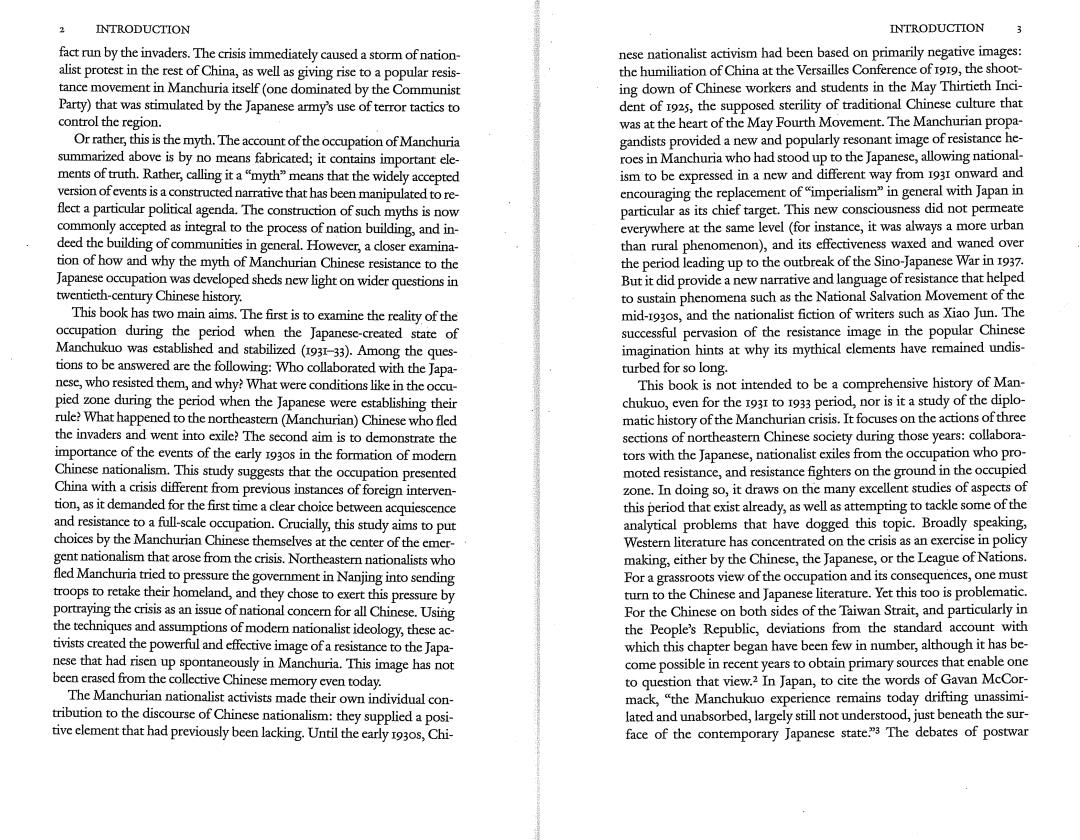正在加载图片...

2 INTRODUCTION INTRODUCTION 3 fact run by the invaders.The crisis immediately caused a storm of nation- nese nationalist activism had been based on primarily negative images: alist protest in the rest of China,as well as giving rise to a popular resis- the humiliation of China at the Versailles Conference of r919,the shoot- tance movement in Manchuria itself(one dominated by the Communist ing down of Chinese workers and students in the May Thirticth Inci- Party)that was stimulated by the Japanese army's use of terror tactics to dent of 1925,the supposed sterility of traditional Chinese culture that control the region. was at the heart of the May Fourth Movement.The Manchurian propa- Or rather,this is the myth.The account of the occupation of Manchuria gandists provided a new and popularly resonant image of resistance he- summarized above is by no means fabricated;it contains important ele- roes in Manchuria who had stood up to the Japanese,allowing national- ments of truth.Rather,calling it a"myth"means that the widely accepted ism to be expressed in a new and different way from 193r onward and version ofevents is a constructed narrative that has been manipulated to re- encouraging the replacement of"imperialism in general with Japan in flect a particular political agenda.The construction of such myths is now particular as its chief target.This new consciousness did not permeate commonly accepted as integral to the process of nation building,and in- everywhere at the same level (for instance,it was always a more urban deed the building of communities in general.However,a closer examina- than rural phenomenon),and its effectiveness waxed and waned over tion of how and why the myth of Manchurian Chinese resistance to the the period leading up to the outbreak of the Sino-Japanese War in 1937. Japanese occupation was developed sheds new light on wider questions in But it did provide a new narrative and language of resistance that helped twentieth-century Chinese history. to sustain phenomena such as the National Salvation Movement of the This book has two main aims.The first is to examine the reality of the mid-193os,and the nationalist fiction of writers such as Xiao Jun.The occupation during the period when the Japanese-created state of successful pervasion of the resistance image in the popular Chinese Manchukuo was established and stabilized(1931-33).Among the ques- imagination hints at why its mythical clements have remained undis- tions to be answered are the following:Who collaborated with the Japa- turbed for so long. nese,who resisted them,and why?What were conditions like in the occu- This book is not intended to be a comprehensive history of Man- pied zone during the period when the Japanese were establishing their chukuo,even for the I93r to 1933 period,nor is it a study of the diplo- rule?What happened to the northeastern (Manchurian)Chinese who fled matic history of the Manchurian crisis.It focuses on the actions of three the invaders and went into exile?The second aim is to demonstrate the sections of northeastern Chinese society during those years:collabora- importance of the events of the early 193os in the formation of modern tors with the Japanese,nationalist exiles from the occupation who pro- Chinese nationalism.This study suggests that the occupation presented moted resistance,and resistance fighters on the ground in the occupied China with a crisis different from previous instances of foreign interven- zone.In doing so,it draws on the many excellent studies of aspects of tion,as it demanded for the first time a clear choice between acquiescence this period that exist already,as well as attempting to tackle some of the and resistance to a full-scale occupation.Crucially,this study aims to put analytical problems that have dogged this topic.Broadly speaking, choices by the Manchurian Chinese themselves at the center of the emer- Western literature has concentrated on the crisis as an exercise in policy gent nationalism that arose from the crisis.Northeastern nationalists who making,either by the Chinese,the Japanese,or the League of Nations. fled Manchuria tried to pressure the government in Nanjing into sending For a grassroots view of the occupation and its consequences,one must troops to retake their homeland,and they chose to exert this pressure by turn to the Chinese and Japanese literature.Yet this too is problematic. portraying the crisis as an issue of national concern for all Chinese.Using For the Chinese on both sides of the Taiwan Strait,and particularly in the techniques and assumptions of modern nationalist ideology,these ac- the People's Republic,deviations from the standard account with tivists created the powerful and effective image of a resistance to the Japa- which this chapter began have been few in number,although it has be- nese that had risen up spontaneously in Manchuria.This image has not come possible in recent years to obtain primary sources that enable one been crased from the collective Chinese memory even today. to question that view.2 In Japan,to cite the words of Gavan McCor- The Manchurian nationalist activists made their own individual con- mack,"the Manchukuo experience remains today drifting unassimi- tribution to the discourse of Chinese nationalism:they supplied a posi- lated and unabsorbed,largely still not understood,just beneath the sur- tive element that had previously been lacking.Until the early 193os,Chi- face of the contemporary Japanese state"3 The debates of postwar